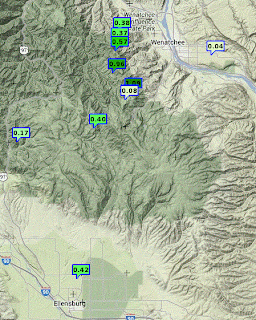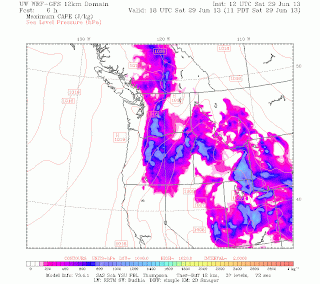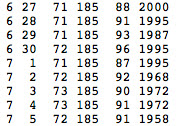You are a high administrator in NOAA (the National Oceanographic and Atmospheric Administration) or a Senator/Congressman on a committee overseeing NOAA.
You know that, due to mismanagement, the U.S. weather satellite program is in trouble and a key satellite program (the polar orbiters) may not be ready before a current satellite fails.
You know such a gap in coverage could have have very serious impacts on the skill of our weather prediction models (and of other nation's as well).
You know there is currently a highly successful, cost-effective satellite system (COSMIC) that uses the bending of GPS signals in the atmosphere (GPS) to produce huge amounts of atmospheric data over the entire planet, data that has been proven to have great benefits for numerical weather prediction.
But those satellites are past their useful life and failing. Another country (Taiwan) has helped support COSMIC and now wants to renew and expand it, at a very opportune time since your polar orbiting satellite may soon fail. AND, Taiwan will pay for HALF the bill, and the U.S. Air Force will pay another quarter. An amazing deal.
So what do you do?
(1) Put a modest amount of funding into the COSMIC program, gaining a huge addition of satellite data and hopefully mitigating the upcoming satellite gap. Others will pay for most of the costs of this system.
(2) You stop all funding for COSMIC and accept full vulnerability for a major satellite gap. You lose the contributions of hundreds of millions of dollars by others.
Amazingly, NOAA management and their congressional overseers seem ready to do (2).
The COSMIC Satellite
This is perhaps one of the most foolish decisions I have seen in a long time, and one that unnecessarily puts American citizens and our economic interests at risk.
As I will describe below, this is a complex story, with some private sector firms doing their best to kill the project. And yes, some ideological elements are at play here. But poor NOAA management is the key element.
A little review, first. The initial COSMIC program, with majority funding from Taiwan, made use of a very clever and inexpensive way to get detailed information on the vertical structure of the atmosphere: launching a constellation of satellites that receive the signals from the GPS (Global Positioning System) satellite system. The degreeof bending of the GPS signal by the atmosphere allows one to get detailed information on the vertical structure of the atmosphere, using a relatively simple (and cheap) satellite system (see graphic below). As the temperature and humidity structure varies, the bending changes. The fancy name for this technique is
radio occultation (RO) and it provides information over the entire planet
The top panel of the next figure shows you the number of vertical profiles over a three hour period from the current COSMIC system. Very nice and includes information over the oceans. Both the National Weather Service and the European Center for Medium Range Weather Forecasting (ECMWF) have analyzed the impact of these observations and found them of great value (top five observations systems) and w
ith the greatest impact per observation.
The COSMIC system (6 satellites launched in 2006) is now beyond its designed life and the satellites are failing. Taiwan has proposed a 400 million dollar replacement (that is cheap for a major satellite system) called COSMIC-2 that put up 12 advanced satellites starting in 2015. The result would be an increase in vertical soundings from around 2000 a day to roughly 10,000 (see bottom panel to get an idea of the difference). And the soundings would be more accurate and of higher quality.
Simulations by ECMWF demonstrated that increased number of COSMIC soundings would substantially improve weather prediction. There have been a number of stories in the media about this issue (
e.g, Houston Chronicle,
Politico)
So why is NOAA management and their Congressional overseers not RUSHING to sign up to contribute to continue and expand the COSMIC program?
Part of the problem is the hapless management of NOAA, which have made mistake after mistake in managing our nation's weather prediction effort (e.g., mismanagement of satellite acquisition, lack of support of weather research. They spent large amounts of money securing opinions about how to handle the satellite gap, but don't take advantage of a potential solution in front of their faces.
Ah, now it is time for the villains of this story. Two private sector firms (
PlanetIQ and
GeoOptics) want to get into the GPS satellite business, which is fine. But neither has successfully launched such a satellite and neither has a working prototype, from what I can tell. But they (and particularly the PlanetIQ crowd) are actively working against COSMIC, providing all kinds of misinformation and unfounded criticisms. For example, a representative of PlanetIQ told me that COSMIC
"misses most of North America, all of Europe and Russia. It also doesn’t
cover most of the South-Pacific, a major contributor to global weather
activity. "
This is totally false, COSMIC and COSMIC-2 have global coverage as illustrated by the map above.
"The experimental COSMIC prototype constellation is dying, the
government of Taiwan has not a penny budgeted for its replacement,"
Not true. COSMIC-2 is well along and Taiwan is investing hundreds of millions of dollars.
There is plenty more of this on their web sites.
These two companies are looking for the U.S. government to agree to purchase data from them,before their systems are launched, essentially looking for a subsidy for their development. They do not have working satellite systems. And keep in mind their prices won't included the 200 million being supplied by Taiwan...U.S. tax payers will pay for the full freight. In fact, they don't seem to be willing to even tell anyone what their data price will be.
This "private sector" solution is being met with sympathy by Republican legislators and some of their Democratic colleagues, who killed support of COSMIC-2 from the Superstorm Sandy supplement. Clearly, our representatives did not understand what they were doing and were letting "ideology" get in the way of a smart, cost-effective solution. Don't get me wrong...I am a great believe in private sector weather observations and space solutions, and I have great respect for companies such as Space-X and AirDat (weather observations on commuter aircraft). But these companies acquired substantial funding and PROVED there were capable of providing a service. And they didn't try to take down viable competitors with inaccurate information.

Repeated attempts to save COSMIC have been defeated and currently there is ZERO funding in the FY 2013 budget. The Taiwanese are getting nervous and are considering scrapping the project...which would be a disaster for the U.S. Congress is now considering the FY 2014 budget, it
is critical that our representatives include full funding of our share of COSMIC in 2014.
To be ready for the 2015 launch of COSMIC-2, software development and necessary hardware acquisition must be started now and it won't be if NOAA funding is not available soon.
So please, contact your Congressmen and Senators and let them know that COSMIC-2 should be supported.



.jpg)

















































